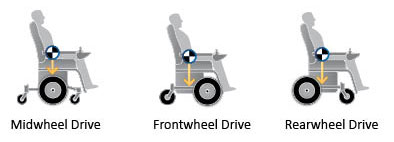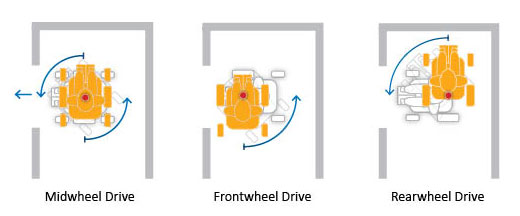Teilen:
Take it offline!
This Education in Motion resource is also available as a printable PDF.
Download PDF
Prescribing a powerchair often poses many challenges as you have to consider a number of factors which may affect the client’s performance in the wheelchair. These considerations can include:
- Postural - such as does the client have a fixed or flexible position?
- Environmental - where will the client be using the chair, e.g. at home, at work, or socially
- Where to mount communication aids
- How the client transfers
- How the client transports the chair - do they have a ‘drive from’ solution, hoist or do they use public transport
All of these considerations can affect which powerchair base is most suitable for the client.
The most important factor is, arguably, the client’s postural considerations. This is something which Sunrise Medical has resolved by using a modular approach to our powered wheelchairs, enabling numerous seating systems to be used on multiple bases, giving the client the flexibility to choose the seating system they want on their chosen powerchair base.
If a client is specifically looking for a powered wheelchair that is suitable for indoor use, there are further considerations that need to be made.
Turning Circle
When prescribing a powerchair it is vital to consider the client’s home environment. One of the most critical movements for any chair is how compactly it turns, as when taken into consideration alongside the space available in the client’s home, this can determine whether a powerchair is suitable or not.
The turning circle of any powered wheelchair is measured from the centre of the drive wheel to the furthest point of the chair (see below image) for each base it is measured as follows:
- Rear-wheel drive - centre of the drive wheel to the end of the user’s feet
- Front-wheel drive - centre of the drive wheel to the rear castor wheel
- Mid-wheel drive - centre of the drive wheel to the end of the user’s feet

Therefore, when considering which drive wheel base provides the most compact turning circle, this is always going to be a mid-wheel drive. Simply because the turning circle is measured from the centre of the drive wheel, which is positioned in the middle of the base to the end of the footplate.
Manoeuvrability
Another key consideration is the overall manoeuvrability of the drive wheel base to ensure the user has the most efficient and best drive base. In this case, let’s consider manoeuvring around a tight corridor to drive around a corner and through a door frame. When approaching the scenario in each drive base, the following would happen:
- Rear-wheel drive - The client would position the chair to the right hand wall to swing the chair around to prevent catching the footplates on the left wall.
- Front-wheel drive - The client would position the chair to the left hand wall by the centre of the door to ensure the rear castor arms do not catch the right hand wall.
- Mid-wheel drive - The client would position the chair in the centre of the hall and turn In this scenario, the mid-wheel drive provides the most intuitive and manoeuvrable drive performance of all three bases.

Overall Chair Size
The final consideration is the overall width of the chair – the narrower and shorter the drive base, the easier it is for the client to navigate tight corridors, doorways and bathrooms in their home and other compact environments. When we developed the Quickie Q300 M we found that a lot of manufacturers at that time were developing bigger chairs for greater outdoor use. However, for many clients and prescribers this caused challenges as users’ homes could only just cope with these larger powered wheelchairs, if at all. The feedback we received suggested that users would rather have a more compact powerchair which would easily manoeuvre around their home environment, and so we developed a smaller powered wheelchair.
The result of this development was the Quickie Q300 M which – with a base width of just 52cm – provides the ultimate indoor mobility, whilst being extremely compact. The Quickie Q300 M also provides the optimum driving characteristics of a mid-wheel drive powered wheelchair, such as a compact turning circle and easy manoeuvrability, allowing users to live with less compromise than before. The Quickie Q300 M is the ultimate indoor performance powered wheelchair in its range and provides excellent manoeuvrability, but for those who have a restricted budget, or who don’t find mid-wheel drive powerchairs very intuitive to operate, there is an alternative – the Quickie Q200 R. This ultra-compact rear-wheel drive base powered wheelchair measures just 58cm wide and provides a compact chassis which can manoeuvre in the tightest environments, whilst having the driving characteristics of a traditional rear-wheel drive.
Sam Owen, Product Specialist - Sunrise Medical UK & Eire